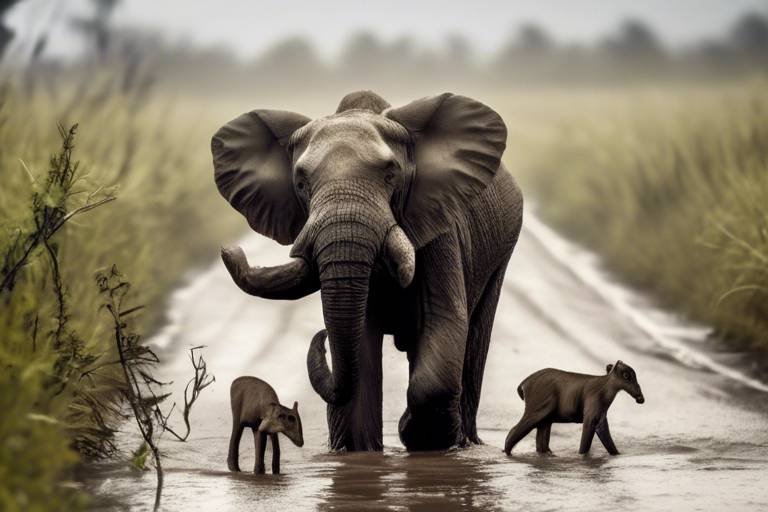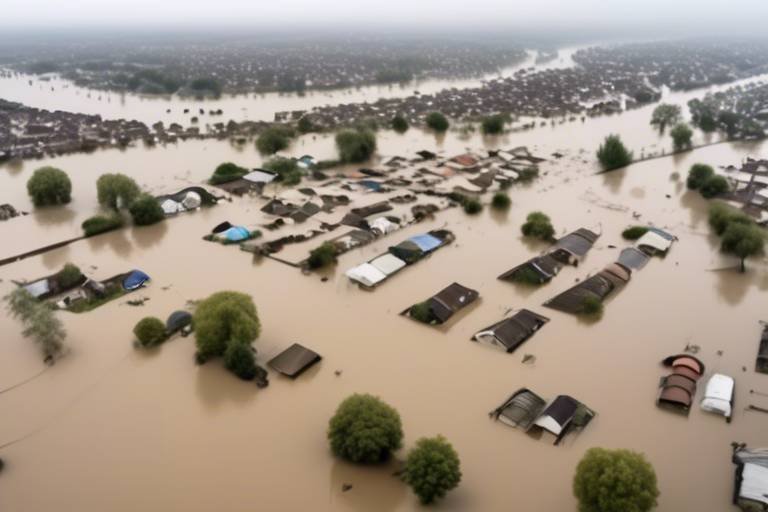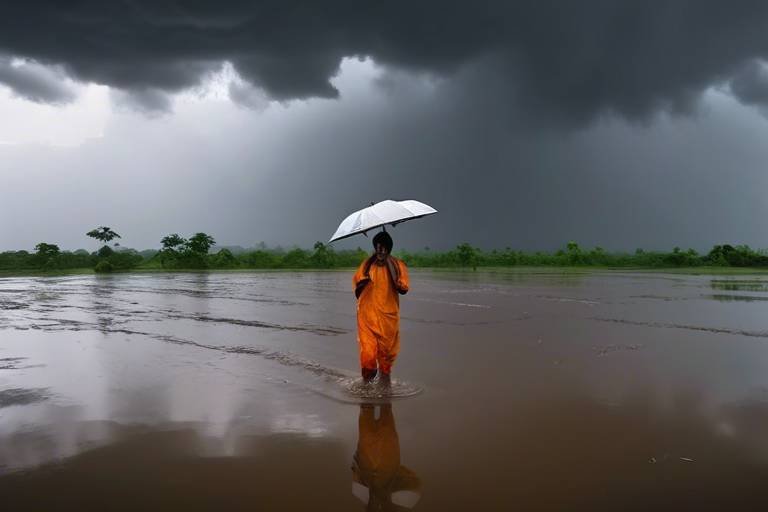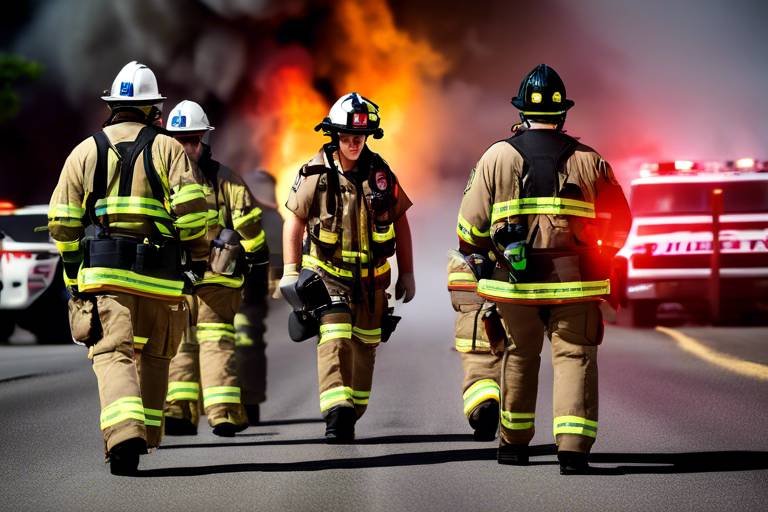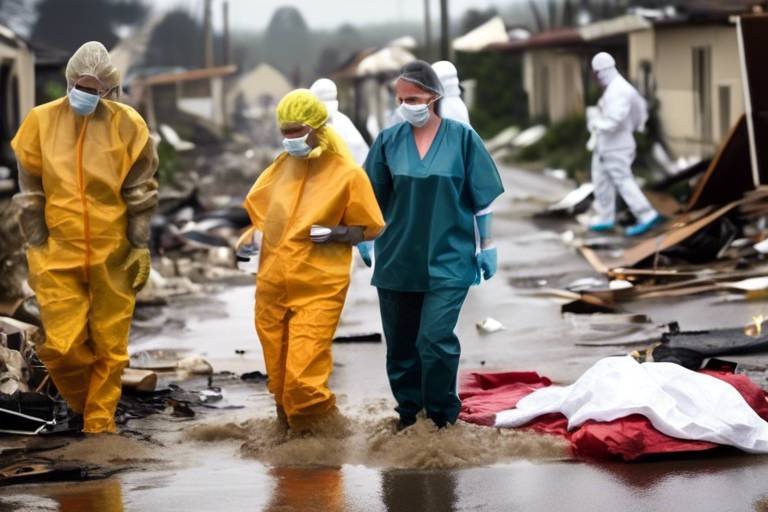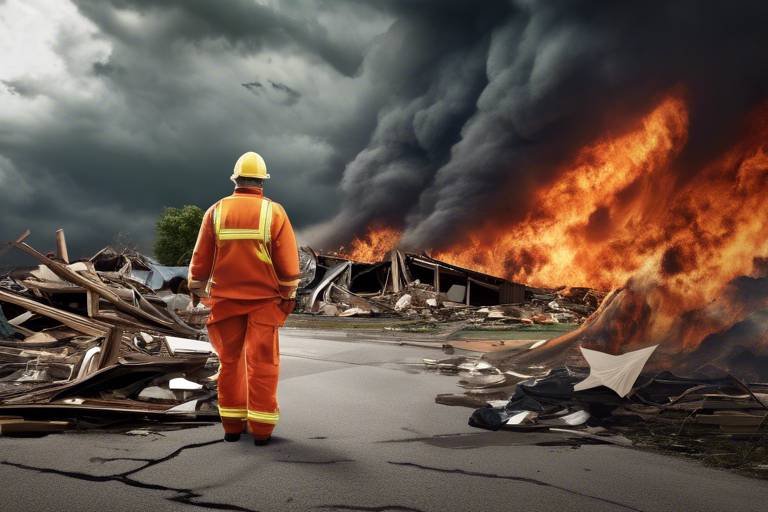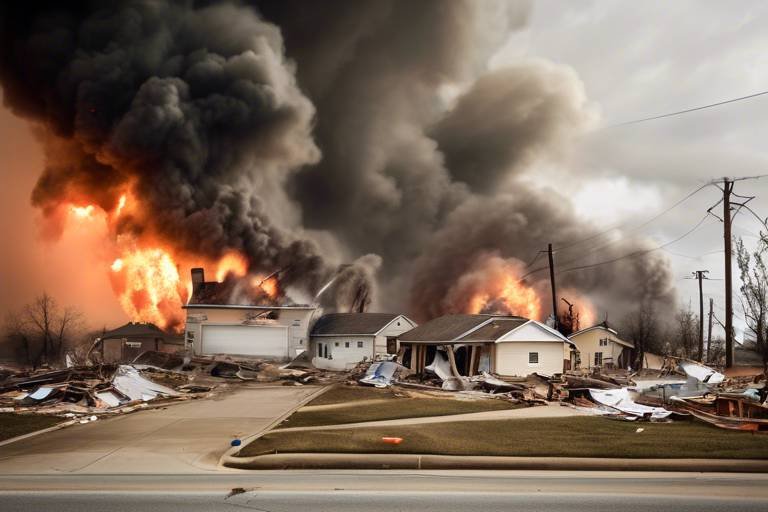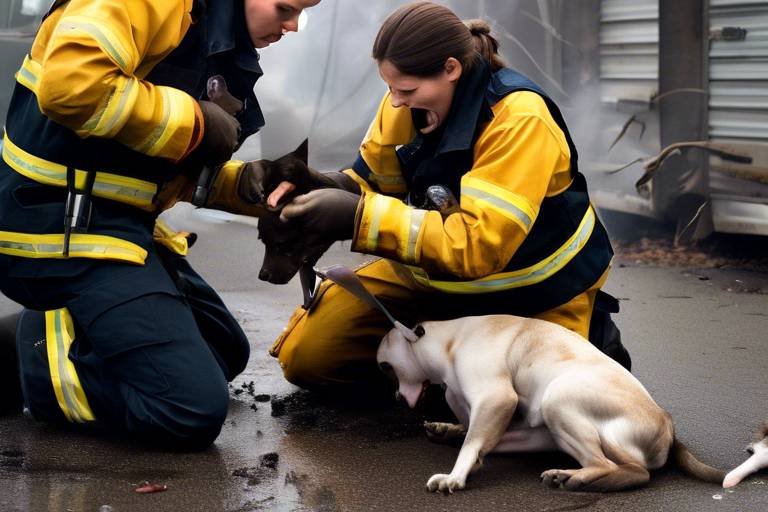Ensuring the Safety of Wildlife during Disasters
Disasters can strike without warning, leaving a trail of devastation in their wake. From wildfires raging through forests to hurricanes sweeping across coastal habitats, the impact on wildlife is often catastrophic. Ensuring the safety of wildlife during such disasters is not just a matter of compassion; it is crucial for maintaining biodiversity and ecosystem health. Animals, much like us, are vulnerable to the chaos that ensues during these events. They face threats such as habitat destruction, food scarcity, and increased competition for dwindling resources. Therefore, it becomes imperative to develop a robust framework of strategies that prioritize their safety and survival.
Imagine a forest where the trees stand tall, providing shelter and food for countless species. Now, picture that same forest consumed by flames. The animals that once thrived there are suddenly displaced, confused, and searching for safety. This scenario highlights the urgent need for effective disaster preparedness plans tailored specifically for wildlife. Such plans should encompass a variety of strategies, including habitat protection, emergency response protocols, and community involvement. By proactively addressing these challenges, we can create a resilient environment that supports wildlife even in the face of adversity.
One of the key components of ensuring wildlife safety is understanding their vulnerabilities. Different species have unique needs and behaviors that dictate how they respond to disasters. For instance, some animals may instinctively flee to higher ground during floods, while others might seek shelter in burrows or trees. Recognizing these behaviors can help conservationists develop targeted interventions that minimize harm. Additionally, creating designated wildlife corridors can facilitate safe movement during disasters, allowing animals to escape danger and find refuge.
As we delve deeper into the strategies for wildlife protection, it's essential to highlight the role of community involvement. Local residents are often the first responders during a disaster. By engaging them in conservation efforts and disaster preparedness training, we can empower communities to act swiftly and effectively. This could involve establishing volunteer networks for wildlife monitoring, organizing training sessions on how to safely rescue stranded animals, and providing resources for reporting changes in wildlife behavior. When communities come together, they can create a powerful force for wildlife conservation.
In conclusion, ensuring the safety of wildlife during disasters requires a multifaceted approach that combines preparedness, community engagement, and ongoing monitoring. By implementing comprehensive disaster plans, protecting habitats, and fostering collaboration among various stakeholders, we can significantly enhance the resilience of wildlife populations. The road to recovery may be long, but with dedication and strategic planning, we can safeguard our planet's precious wildlife for generations to come.
Here are some common questions regarding wildlife safety during disasters:
- What should I do if I find a stranded animal during a disaster?
Contact local wildlife rescue organizations for guidance on how to safely assist the animal. - How can I prepare my property to protect local wildlife?
Maintain natural habitats, create buffer zones, and avoid using harmful chemicals that can affect animal health. - Are there specific species that are more vulnerable during disasters?
Yes, species with limited mobility or those that rely on specific habitats are often more at risk. - How can I get involved in wildlife conservation efforts?
Join local conservation groups, participate in community monitoring programs, or volunteer for wildlife rescue organizations.

Understanding Wildlife Vulnerability
Wildlife faces a myriad of challenges during disasters, and it’s essential to grasp the unique vulnerabilities that these creatures endure. When natural calamities strike—be it hurricanes, wildfires, or floods—their habitats often suffer devastating destruction. Imagine a serene forest suddenly engulfed in flames; the animals that call it home are left scrambling for survival. This scenario highlights the critical need for a deeper understanding of how disasters impact wildlife.
One of the most pressing issues is habitat destruction. When a disaster occurs, the natural environment that provides food, shelter, and breeding grounds for wildlife can be obliterated in mere moments. For instance, a flood can wash away nesting sites for birds or drown small mammals that can’t escape the rising waters. Furthermore, the aftermath of such events often leads to food scarcity. With their habitats destroyed, animals may find it increasingly difficult to locate food sources. This scarcity not only threatens their immediate survival but can also have long-term effects on population dynamics and species recovery.
Another significant factor is the disruption of migration patterns. Many species rely on migratory routes that are often obstructed by natural disasters. For example, if a wildfire sweeps through a region, it can block the paths that migratory birds have used for generations. This disruption can lead to decreased reproductive success and increased mortality rates as animals struggle to adapt to their new, altered landscapes.
Moreover, the vulnerability of wildlife is compounded by human activities that exacerbate the effects of disasters. Urban development, deforestation, and climate change all play a role in making wildlife more susceptible to the impacts of natural calamities. As humans encroach upon natural habitats, animals are forced into smaller and often less suitable areas, making them more vulnerable during disasters.
To effectively mitigate these vulnerabilities, it is crucial to implement conservation strategies that address both immediate and long-term needs. This includes:
- Habitat Restoration: Rebuilding and restoring damaged ecosystems to provide safe havens for wildlife.
- Monitoring Programs: Establishing systems to track wildlife health and behavior during and after disasters.
- Community Engagement: Involving local communities in conservation efforts to enhance awareness and action.
In summary, understanding wildlife vulnerability is a fundamental step in developing effective disaster response strategies. By recognizing the unique challenges faced by wildlife, we can create targeted conservation efforts that not only protect these species during disasters but also help them thrive in the long run.

Disaster Preparedness Plans
When it comes to safeguarding our precious wildlife during disasters, are absolutely essential. Imagine a world where animals are left to fend for themselves amidst chaos—it's a scenario we simply cannot afford. These plans should be meticulously crafted, taking into account the unique needs of various species and their habitats. After all, just like humans, wildlife requires a safe haven, especially when nature decides to throw a tantrum.
First and foremost, a comprehensive disaster preparedness plan must include habitat protection. This means identifying critical habitats that are vital for the survival of different species and ensuring they are shielded from potential threats. For instance, wetlands, forests, and coastal areas often serve as crucial refuges for wildlife. By implementing protective measures such as creating buffer zones, we can help mitigate the impacts of disasters.
Another key component is establishing evacuation routes for wildlife. Just as cities have emergency exit plans for residents, we need to think about how animals can safely relocate during a disaster. This might involve creating corridors that allow animals to move to safer areas without encountering human-made obstacles. Imagine a deer gracefully navigating through a designated path, avoiding roads and buildings, all thanks to thoughtful planning.
Additionally, emergency response protocols tailored to specific species and ecosystems are vital. For example, if a flood is imminent, we need to have a plan in place to assist aquatic species that might be displaced. This could involve setting up temporary shelters or safe zones where affected wildlife can be monitored and cared for until the situation stabilizes.
But here's the kicker: these plans are not just the responsibility of wildlife organizations. Engaging local communities in the process is crucial. When residents are informed and involved, they can become the eyes and ears of conservation efforts. They can help in monitoring wildlife, reporting unusual behaviors, and even participating in rescue operations. It’s a community effort, and together, we can create a safety net for our wildlife.
In summary, a well-thought-out disaster preparedness plan is a lifeline for wildlife. It encompasses habitat protection, evacuation routes, and tailored emergency protocols, all while fostering community involvement. By taking these proactive steps, we can ensure that when disaster strikes, our wildlife has a fighting chance to survive and thrive.
- What is a disaster preparedness plan for wildlife?
A disaster preparedness plan for wildlife outlines strategies and actions needed to protect animal populations and their habitats during natural disasters. - Why is community involvement important in wildlife conservation?
Community involvement enhances awareness and monitoring of wildlife, allowing for quicker responses and better support during disasters. - What are some examples of habitat protection strategies?
Examples include creating buffer zones, preserving critical habitats, and implementing land-use planning to minimize risks.

Habitat Protection Strategies
When it comes to safeguarding wildlife during disasters, serve as the first line of defense. Imagine a fortress built to shield precious inhabitants from the chaos outside; that's precisely what we aim to create for wildlife. The key is to implement protective measures well before a disaster strikes, ensuring that animals have a safe haven when calamity looms. One effective approach is the preservation of critical habitats. These areas, rich in biodiversity, provide essential resources for wildlife, including food, shelter, and breeding grounds. By conserving these habitats, we not only protect the animals that rely on them but also maintain the ecological balance that supports entire ecosystems.
Another vital strategy involves the establishment of buffer zones. Think of these zones as safety nets, designed to absorb the impacts of natural hazards like floods, wildfires, or storms. Buffer zones can be created by planting trees, restoring wetlands, or maintaining open spaces around critical habitats. These areas can act as a buffer against the forces of nature, reducing the immediate impact on wildlife and giving them a chance to escape to safer grounds.
Furthermore, it's essential to engage in land-use planning that prioritizes wildlife habitats. This means that when communities expand, they must do so with an awareness of the surrounding ecosystems. By integrating wildlife corridors—designated pathways that allow animals to move safely between habitats—we can ensure that even in times of disaster, animals have routes to safety. These corridors can be as simple as maintaining existing green spaces or as elaborate as creating overpasses and underpasses that facilitate safe crossings over roads.
To illustrate the importance of these strategies, consider the following table that highlights the various habitat protection measures and their benefits:
| Habitat Protection Measure | Benefits |
|---|---|
| Preservation of Critical Habitats | Provides food, shelter, and breeding areas for wildlife. |
| Establishment of Buffer Zones | Reduces the impact of natural disasters and protects wildlife. |
| Integration of Wildlife Corridors | Facilitates safe movement between habitats, ensuring access to resources. |
In addition to these strategies, community involvement is paramount. Local residents often possess invaluable knowledge about the land and its wildlife, making them essential allies in habitat protection efforts. By fostering a sense of stewardship within communities, we can harness collective power to monitor and protect these vital areas. After all, when communities unite for a common cause, the impact can be profound.
In conclusion, habitat protection strategies are not just about preserving land; they are about ensuring a future for wildlife in the face of disasters. By implementing these measures proactively and engaging communities, we can create a resilient environment where wildlife can thrive, even amidst chaos.
- What are critical habitats? Critical habitats are areas essential for the survival and reproduction of endangered or threatened species.
- How do buffer zones work? Buffer zones absorb the impact of natural disasters, protecting wildlife from immediate harm.
- Why are wildlife corridors important? They allow animals to safely navigate between habitats, promoting genetic diversity and resilience.

Restoration of Natural Habitats
Restoring natural habitats after a disaster is not just a noble endeavor; it is a crucial step towards ensuring the survival of countless wildlife species. When disasters strike, whether they are wildfires, floods, or hurricanes, the aftermath can leave ecosystems in shambles. The soil may be eroded, plant life may be decimated, and food sources for animals may vanish overnight. This is where the restoration process comes into play, acting as a lifeline for both flora and fauna.
The restoration process involves several key actions aimed at revitalizing the damaged ecosystem. First and foremost, replanting native vegetation is essential. Native plants are adapted to the local environment and provide the necessary habitat and food for wildlife. Unlike non-native species, which can sometimes take over and disrupt the ecosystem balance, native plants help maintain the integrity of the habitat. This is akin to putting the right puzzle pieces back together after they've been scattered. When these plants are replanted, they not only restore the landscape but also create a welcoming environment for animals to return.
Additionally, removing debris is another critical aspect of habitat restoration. After a disaster, landscapes can be littered with fallen trees, rocks, and other materials that can hinder wildlife movement and access to food. Clearing these obstacles allows animals to navigate their environment freely, reducing stress and enhancing their chances of survival. Imagine trying to walk through a maze with walls that keep shifting; it’s frustrating and disorienting. By removing debris, we create a clearer path for wildlife to reclaim their territory.
Moreover, it’s vital to ensure that the ecosystem can support returning animal populations. This may involve monitoring soil health and ensuring that water sources are clean and accessible. Healthy soil is the foundation of a thriving habitat, as it supports plant growth and, by extension, the entire food web. Regular assessments can help identify any lingering issues that could impede recovery, allowing for timely interventions. Think of it as a doctor’s check-up; just as we monitor our health to catch potential problems early, ecosystems need the same level of attention.
Involving the community in habitat restoration efforts can also amplify the impact. Local volunteers can participate in replanting initiatives, clean-up drives, and monitoring programs. This not only fosters a sense of ownership and responsibility towards the environment but also educates the public about the importance of preserving wildlife habitats. Community engagement is like a ripple effect; one small action can lead to significant change. By working together, we can ensure that the restoration process is not just a one-time event but a continuous effort that nurtures our natural landscapes.
In conclusion, restoring natural habitats post-disaster is a multifaceted process that requires careful planning, community involvement, and ongoing monitoring. By focusing on native vegetation, debris removal, and ecosystem health, we can create a thriving environment for wildlife to return and flourish. The road to recovery may be long, but the benefits of a restored habitat are immeasurable, providing a sanctuary for wildlife and a reminder of nature's resilience.
- What is the first step in restoring a natural habitat after a disaster? The first step typically involves assessing the damage and identifying the key areas that need immediate attention, such as replanting native vegetation.
- How can communities get involved in habitat restoration? Communities can participate by volunteering for local restoration projects, helping with clean-up efforts, and spreading awareness about the importance of wildlife conservation.
- Why is native vegetation important in habitat restoration? Native vegetation is crucial because it is adapted to the local environment, supports local wildlife, and helps maintain the ecological balance.
- What role does soil health play in habitat restoration? Healthy soil is essential for plant growth, which in turn supports the entire ecosystem. Monitoring and improving soil health can significantly enhance the recovery process.

Community Involvement in Conservation
When it comes to protecting wildlife during disasters, the role of local communities cannot be overstated. In fact, community involvement is like the backbone of conservation efforts; without it, many initiatives may falter. Imagine a tightly-knit neighborhood coming together to safeguard a beloved local park or wildlife sanctuary. This collective action not only boosts morale but also enhances the effectiveness of conservation strategies. Communities are often the first responders to environmental changes, and their intimate knowledge of local ecosystems can provide invaluable insights into wildlife behaviors and needs during crises.
One of the most significant ways communities can contribute is through active monitoring. Local residents can keep an eye on wildlife populations, noting any unusual behaviors or signs of distress. This grassroots surveillance can be crucial during disasters, as it allows for quick reporting of issues that might otherwise go unnoticed. For instance, if a community member sees a sudden decline in bird populations or notices that animals are behaving erratically, they can alert conservation organizations, prompting immediate action.
Moreover, community involvement fosters a sense of stewardship. When people feel connected to their local wildlife, they are more likely to engage in conservation efforts. This can range from participating in clean-up drives to advocating for policies that protect habitats. Educational programs can also empower community members to understand the importance of biodiversity and the specific needs of local wildlife. Workshops, school programs, and public seminars can serve as platforms for sharing knowledge and inspiring action.
Additionally, forming partnerships with local organizations can amplify conservation efforts. For example, community groups can collaborate with wildlife agencies to create disaster preparedness plans tailored to specific species in the area. These plans may include establishing wildlife corridors or creating emergency feeding stations to support animals during food shortages. By pooling resources and expertise, communities can develop robust strategies that enhance resilience against disasters.
In conclusion, the active participation of communities in conservation is essential for effective wildlife protection during disasters. Their unique insights, commitment, and ability to mobilize resources can make a world of difference in safeguarding our natural heritage. As we face an increasing number of environmental challenges, fostering this community spirit will be crucial in building a sustainable future for both wildlife and humans alike.
- Why is community involvement important in wildlife conservation?
Community involvement is crucial because local residents have firsthand knowledge of their ecosystems, which can enhance monitoring and response efforts during disasters. - How can communities participate in wildlife conservation efforts?
Communities can engage through monitoring wildlife, participating in educational programs, forming partnerships with conservation organizations, and advocating for protective policies. - What role do local residents play during a disaster?
Local residents often act as the first responders, providing vital information about wildlife conditions and assisting in rescue and recovery efforts. - How can education help in conservation?
Educational programs raise awareness about the importance of biodiversity and equip community members with the knowledge needed to take action for wildlife protection.

Emergency Response for Wildlife
When disaster strikes, the clock is ticking, and every second counts in ensuring the safety of our wildlife. Effective emergency response for wildlife is not just a luxury; it’s a necessity that requires a well-coordinated effort among various organizations and stakeholders. Imagine a bustling rescue operation where every individual plays a crucial role, much like a well-oiled machine. This response involves several critical components, including the rescue of stranded animals, provision of medical care, and safe relocation when necessary.
First and foremost, the immediate goal during a disaster is to rescue stranded animals. This can be a daunting task, especially in the chaos that ensues during events like wildfires or floods. Trained professionals, often in collaboration with local volunteers, are essential in these situations. They assess the areas most affected and prioritize rescue operations based on the severity of the threat to various species. For example, larger animals may require different handling techniques compared to smaller wildlife, and understanding these nuances can save lives.
Once animals are rescued, the next step is providing medical care. Injured wildlife may need urgent attention, and having a network of wildlife veterinarians and rehabilitation experts is vital. These professionals can administer first aid, treat injuries, and stabilize animals before they can be released back into their natural habitats. In many cases, animals may need to be kept in rehabilitation centers until they are fit for release. This process can take time, but it’s essential for ensuring that the animals can thrive once returned to the wild.
Another crucial aspect of emergency response is the safe relocation of wildlife if their original habitat has been compromised. This can involve moving animals to nearby safe zones or even creating new habitats when necessary. Relocation must be done with great care, as animals need to adapt to new environments, which can be stressful. The relocation process often includes monitoring the animals post-release to ensure they are adjusting well and can survive on their own.
Moreover, coordination among various organizations is key. Local wildlife agencies, NGOs, and community volunteers must work hand in hand. This collaboration can be enhanced through regular training and drills that prepare all parties for real-life scenarios. For instance, having a clear communication plan can streamline efforts during a disaster, ensuring that everyone knows their roles and responsibilities.
To illustrate the importance of a structured response, consider the following table that outlines the essential roles in an emergency wildlife response team:
| Role | Responsibilities |
|---|---|
| Wildlife Rescuer | Conducts field rescues, assesses animal conditions. |
| Veterinarian | Provides medical treatment and rehabilitation. |
| Ecologist | Assesses habitat conditions and guides relocation efforts. |
| Community Volunteer | Supports rescue efforts, assists in communication. |
In conclusion, an effective emergency response for wildlife is a multifaceted approach that not only saves lives but also aids in the recovery of ecosystems. By prioritizing rescue operations, providing medical care, and ensuring safe relocation, we can help wildlife navigate the aftermath of disasters. As stewards of the environment, it’s our duty to ensure that wildlife not only survives but thrives in the face of adversity.
- What should I do if I find an injured wild animal?
Contact local wildlife authorities or a veterinarian specializing in wildlife for assistance. - How can I help wildlife during a disaster?
Get involved with local conservation groups and stay informed about wildlife rescue efforts in your area. - What types of disasters most affect wildlife?
Natural disasters like floods, wildfires, and hurricanes can devastate habitats and displace animal populations.

Monitoring Wildlife Health
Monitoring the health of wildlife populations during and after disasters is not just a precaution; it’s a necessity. When a natural calamity strikes, it can send shockwaves through ecosystems, leaving wildlife vulnerable to a host of problems, from injuries to disease outbreaks. Imagine a forest ravaged by wildfire or a river flooded beyond its banks—these events disrupt not only the physical landscape but also the delicate balance of life within it. That’s why keeping a close eye on the health of these populations is crucial for ensuring their survival and the stability of their habitats.
One of the primary reasons to monitor wildlife health is to quickly identify disease outbreaks that may arise in the aftermath of a disaster. When animals are stressed, their immune systems can weaken, making them more susceptible to infections. For example, after a hurricane, the stress of displacement can lead to increased incidences of respiratory diseases among birds. Regular health assessments can help conservationists catch these issues early, allowing for timely interventions.
Moreover, understanding the stress factors affecting wildlife is essential for their recovery. Stress can stem from a variety of sources, including habitat loss, food scarcity, and human interference. By closely monitoring wildlife behavior and health, researchers can develop targeted strategies to alleviate these stressors. For instance, if a particular species shows signs of malnutrition after a disaster, conservationists can implement supplementary feeding programs to help them recover.
To facilitate effective monitoring, several methods can be employed:
- Field Surveys: Regular field surveys can help track population numbers and health indicators.
- Remote Sensing: Utilizing technology, such as drones or satellite imagery, can provide insights into habitat changes and wildlife movement.
- Health Assessments: Conducting health assessments through physical examinations and sampling can reveal critical health data.
In addition to these methods, community involvement plays a pivotal role in monitoring wildlife health. Local residents often have valuable knowledge about wildlife behavior and can report unusual sightings or health issues. This grassroots effort not only enhances data collection but also fosters a sense of stewardship among community members, making them active participants in conservation efforts.
Ultimately, the goal of monitoring wildlife health is to ensure that animal populations can rebound after disasters. By understanding the challenges they face and implementing effective monitoring strategies, we can help safeguard these species for future generations. It’s not just about watching from the sidelines; it’s about taking action to protect the intricate web of life that depends on a healthy environment.
Q: Why is monitoring wildlife health important after a disaster?
A: Monitoring wildlife health is crucial to identify disease outbreaks and stress factors that can affect animal survival and reproduction. Early detection allows for timely interventions that can help stabilize populations.
Q: How can communities contribute to wildlife health monitoring?
A: Communities can play a significant role by reporting unusual wildlife behavior, participating in surveys, and supporting local conservation initiatives. Their observations can provide valuable data for researchers.
Q: What methods are used to monitor wildlife health?
A: Common methods include field surveys, remote sensing technologies, and health assessments through physical examinations and sampling.

Research and Data Collection
Research and data collection play a pivotal role in understanding wildlife behavior during disasters. By systematically studying how various species respond to environmental changes, we can develop more effective conservation strategies. Imagine trying to navigate a maze without knowing the layout; that’s what wildlife conservationists face without proper data. The insights gained from research can illuminate the paths that animals take, their migration patterns, and their survival tactics in the face of adversity.
One of the primary methods for gathering this invaluable information is through field studies. Researchers often deploy tracking devices on animals to monitor their movements and behaviors in real-time. This technology has revolutionized our understanding of wildlife, allowing us to observe how animals react to disasters such as floods, wildfires, and earthquakes. For instance, studies have shown that certain species may exhibit panic behaviors during a disaster, leading them to flee to less suitable habitats, which can ultimately threaten their survival.
In addition to field studies, community science initiatives have emerged as a powerful tool for data collection. Local communities can contribute significantly by reporting wildlife sightings and changes in animal behavior during and after disasters. This grassroots approach not only fosters a sense of ownership among community members but also enriches the data pool available for researchers. By collaborating with local volunteers, scientists can gather a broader range of data that might otherwise go unnoticed.
Moreover, utilizing technology such as remote sensing and aerial surveys can provide a comprehensive overview of affected habitats. These methods allow researchers to assess changes in land use, vegetation cover, and overall ecosystem health. For example, after a wildfire, satellite imagery can reveal the extent of habitat loss, helping conservationists prioritize areas for restoration efforts. The combination of traditional research methods and cutting-edge technology creates a robust framework for understanding wildlife resilience.
As we gather more data, it's crucial to analyze it effectively. This is where statistical models come into play, helping researchers predict future trends and potential risks to wildlife populations. By understanding the factors that contribute to vulnerability, conservationists can devise proactive measures to protect these species. For example, if data indicates that a specific animal population is declining due to habitat destruction, targeted conservation efforts can be implemented to address the issue before it escalates.
In summary, research and data collection are the backbone of effective wildlife conservation strategies during disasters. By employing a mix of field studies, community involvement, and advanced technology, we can better understand and protect our wildlife. The more we know about how animals react to disasters, the more equipped we are to ensure their survival and recovery.
- Why is research important for wildlife during disasters?
Research provides the necessary data to understand animal behavior, which helps in creating effective conservation strategies. - How can local communities help in wildlife research?
Local communities can participate by reporting wildlife sightings and changes in behavior, contributing valuable data for researchers. - What technologies are used in wildlife research?
Technologies such as GPS tracking, remote sensing, and aerial surveys are commonly used to gather data on wildlife movements and habitat changes. - What role do statistical models play in wildlife conservation?
Statistical models help predict trends and assess risks to wildlife populations, informing conservation strategies.

Long-term Conservation Strategies
This article explores the various strategies and measures necessary to protect wildlife during disasters, emphasizing the importance of preparedness, response, and recovery efforts for both animals and their habitats.
Wildlife faces unique challenges during disasters, including habitat destruction and food scarcity. Understanding these vulnerabilities is crucial for developing effective conservation strategies that can mitigate the impacts of natural calamities.
Creating comprehensive disaster preparedness plans is essential for wildlife conservation. These plans should include habitat protection, evacuation routes, and emergency response protocols tailored to specific species and ecosystems.
Implementing habitat protection strategies before disasters occur can significantly reduce the impact on wildlife. This includes preserving critical habitats and creating buffer zones to shield animals from natural hazards.
Post-disaster, restoring natural habitats is vital for wildlife recovery. This process involves replanting native vegetation, removing debris, and ensuring the ecosystem can support the returning animal populations.
Engaging local communities in wildlife conservation efforts enhances disaster preparedness. Community members can play a key role in monitoring wildlife and reporting changes in their environment during and after disasters.
Effective emergency response for wildlife involves coordinated efforts among various organizations. This includes rescuing stranded animals, providing medical care, and ensuring safe relocation when necessary.
Monitoring the health of wildlife populations during and after disasters is essential. Regular assessments can help identify disease outbreaks and stress factors that affect animal survival and reproduction.
Conducting research and collecting data on wildlife behavior during disasters can inform future response strategies. Understanding how different species react can improve preparedness and conservation efforts.
Developing long-term conservation strategies is crucial for enhancing wildlife resilience to disasters. These strategies are not just about immediate response; they involve a holistic approach to sustaining ecosystems over time. For instance, habitat restoration is a key component. This means actively working to restore areas that have been damaged, ensuring that native flora and fauna can thrive once again. It’s like giving nature a second chance to recover and flourish.
Moreover, climate adaptation measures are becoming increasingly important. As climate change alters habitats, wildlife needs to adapt to new conditions. This could involve creating wildlife corridors that allow animals to migrate to more suitable environments, ensuring they have the space and resources they need to survive.
Another essential aspect is sustainable land-use planning. This means making decisions about land development that consider the long-term impacts on wildlife and their habitats. By integrating wildlife conservation into urban planning and agricultural practices, we can minimize habitat loss and fragmentation. To visualize this, consider a table that outlines the various strategies and their impacts:
| Conservation Strategy | Description | Impact on Wildlife |
|---|---|---|
| Habitat Restoration | Replanting native species and cleaning up ecosystems. | Provides a safe environment for wildlife to thrive. |
| Climate Adaptation | Creating corridors for migration and adjusting habitats. | Enhances species resilience to climate changes. |
| Sustainable Land Use | Planning developments with wildlife needs in mind. | Reduces habitat loss and promotes biodiversity. |
By adopting these long-term strategies, we can significantly bolster the ability of wildlife to withstand and recover from disasters. It’s not just about saving animals; it’s about preserving the intricate web of life that supports us all.
- What are the main threats to wildlife during disasters?
Wildlife faces threats such as habitat destruction, food scarcity, and increased predation during disasters.
- How can communities help protect wildlife?
Communities can help by participating in conservation efforts, monitoring wildlife, and reporting changes in the environment.
- What role does habitat restoration play in wildlife recovery?
Habitat restoration is crucial as it provides a safe environment for wildlife to return and thrive after a disaster.
- How can climate change affect wildlife conservation efforts?
Climate change can alter habitats, making it essential for conservation strategies to adapt to ensure wildlife resilience.
Frequently Asked Questions
- What are the main vulnerabilities of wildlife during disasters?
Wildlife faces numerous challenges during disasters, such as habitat destruction, food scarcity, and increased competition for resources. These vulnerabilities can lead to population declines and even extinction if not addressed properly.
- How can communities prepare for wildlife conservation during disasters?
Communities can prepare by developing disaster preparedness plans that include habitat protection, establishing evacuation routes for wildlife, and training local volunteers to assist in monitoring wildlife during and after a disaster.
- What strategies can be implemented for habitat protection?
Strategies for habitat protection include creating buffer zones around critical habitats, preserving natural landscapes, and restoring degraded areas before disasters strike. These measures help shield wildlife from the worst impacts of natural calamities.
- What role does community involvement play in wildlife conservation?
Community involvement is crucial as local residents can monitor wildlife, report changes, and assist in rescue efforts during disasters. Engaging the community fosters a sense of responsibility and enhances conservation efforts.
- How is wildlife health monitored during and after disasters?
Wildlife health is monitored through regular assessments that identify signs of disease outbreaks, stress factors, and overall population health. This information is vital for implementing timely conservation measures and ensuring species survival.
- What are the long-term strategies for wildlife conservation?
Long-term strategies include habitat restoration, climate adaptation measures, and sustainable land-use planning. These approaches aim to enhance wildlife resilience to future disasters and safeguard ecosystems for generations to come.
- How does research contribute to wildlife disaster preparedness?
Research provides valuable insights into wildlife behavior during disasters, helping conservationists understand how different species react. This information is essential for improving preparedness and response strategies in future events.

